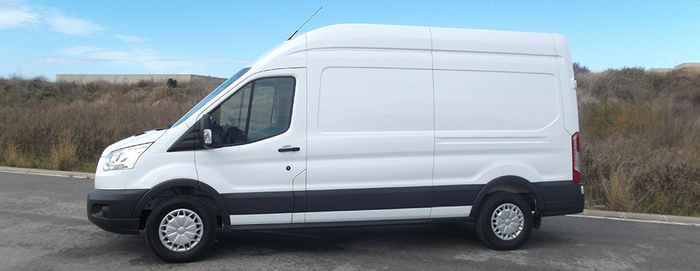Ford Transit

European Press Launch, Barcelona
The Transit was originally launched in 1965 and has been the best-selling van in the UK every year since. It has been a phenomenal success and has become an icon. In the UK Transit is often used as a generic term to describe this size of van, no matter what the model is.
Over seven million Transits have been sold worldwide, with 2.2 million of those in the UK. Ford say that there are currently over 700,000 on British roads and used daily. One in four vans on our roads is a Transit.
The Transit family of models is the 6th best-selling model in the UK, ahead of the BMW 3 Series but behind other popular Fords such as the Fiesta and Focus which tend to take the top seller title a lot of the time.

This is the “full size” version of the Transit that tops the range, which is now made of up of Transit Courier, Transit Connect and Transit Custom. It’s getting a little confusing with such widespread use of the Transit name. But each size of van has a use in mind and competitor to line up against.
The number of derivatives that are available to order is massive, due to there being so many key variables. There are various wheelbases, roof heights, engine powers and weights. There are over 450 different derivatives due to all these permutations. There are many body options for the chassis versions too, things such as tippers, dropsides, fridges, lutons and box vans: the list appears endless with a van for so many applications. Minibuses are on offer too, with seating capacities varying from 11 to 18 seats.
The exterior is very different to the current model, with a bold grille, new headlights and all new panels throughout; it feels more solid and has more appeal. When you first see it, it looks perhaps a bit too aggressive, although after a short while, it begins to grow on you and very quickly you begin to like it. I’m sure that as we begin to see it appearing on Britain’s roads, it will very quickly become the norm.
All new Transits are powered by the Dagenham built 2.2-Litre Duratorq diesel engine, with three power outputs: 100ps, 125ps and 155ps. We tried the middle and top end power units. We found the 125ps to be the most efficient and also quieter than the 155ps. The midrange engine has more than enough power, even when carrying maximum weight.

The new Transit is also available with front-wheel drive, rear-wheel drive and four-wheel drive. Fleet sales will account 80% of sales and Ford have 2,300 current fleet buyers.
Production of the new Transit starts in Spring at Fords Plant in Kocaeli in Turkey, other plants will also produce this new model in North America and Russia.
We drove a variety of vehicles around Barcelona, on the motorways, and up into the hills, and found it to be a superb drive in all conditions, on all road surfaces and whatever weight was on-board, it was on top of the job, regardless. It was very quiet from road, engine and wind-noise, but there was a fair amount of noise from the large door mirrors, which just spoilt it a bit. The engineers and designers have managed significant advances in stability, and therefore improving driver appeal, and making it much safer.
The interior is a massive improvement, and is more “car-like” than “van-like”. There is no metal showing in the cab, as everything is covered by material or plastic, which is up to a very high standard. The steering wheel on the vans we drove is more akin to a luxury German car, with high quality material and stitching in abundance.
The knobs and switches on the dash for the radio, media, phone etc. are very similar to the Ford cars, such as the Fiesta and Focus, and like the cars, they are a little complicated and clumsy, and make the centre of the dash look a bit cluttered, and not easy on the eye.

The new Transit is full of new technology and safety features that until a couple of years ago would not be found on most passenger cars, but all adds to driving pleasure, and helps keep the driver and passengers safe.
But with all this new modern technology, a cabin fit for a king, superb handling, fully spec’d… in a van? – does your average White-Van-Man actually need it, or more importantly, want it?
With all due respect to van drivers, will they respect their new environment, by wiping their feet before getting in, wash their hands in Swarfega before touching the very expensive and very nice steering wheel - probably not. This extremely modern, well finished van, that looks a million dollars when new, will probably just look wrecked at the end of three years, just like every other van or pickup, which is a shame.
Or maybe, just maybe, a bit of love and attention may be introduced.
Martin Ward, Manufacturer Relationship Manager


